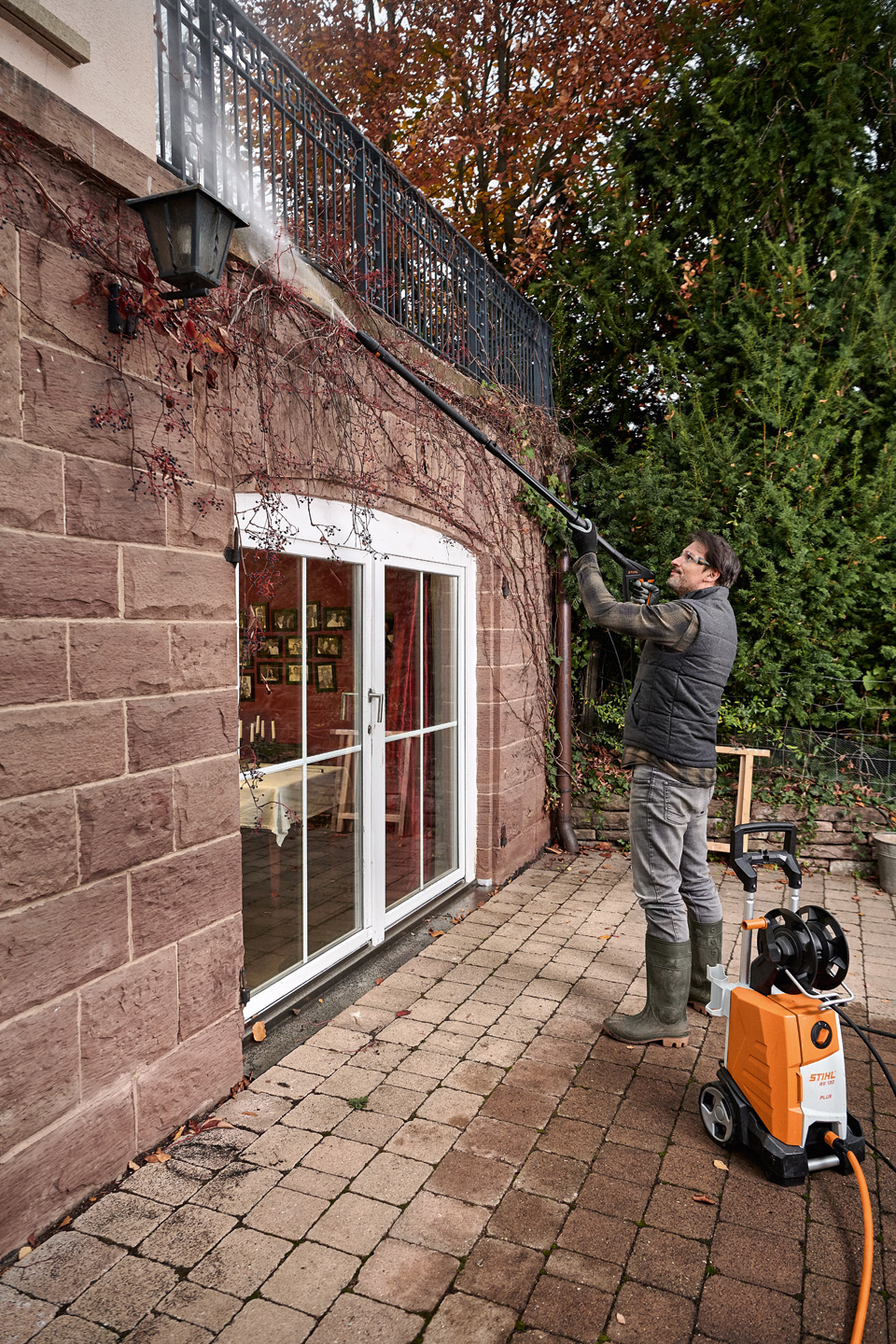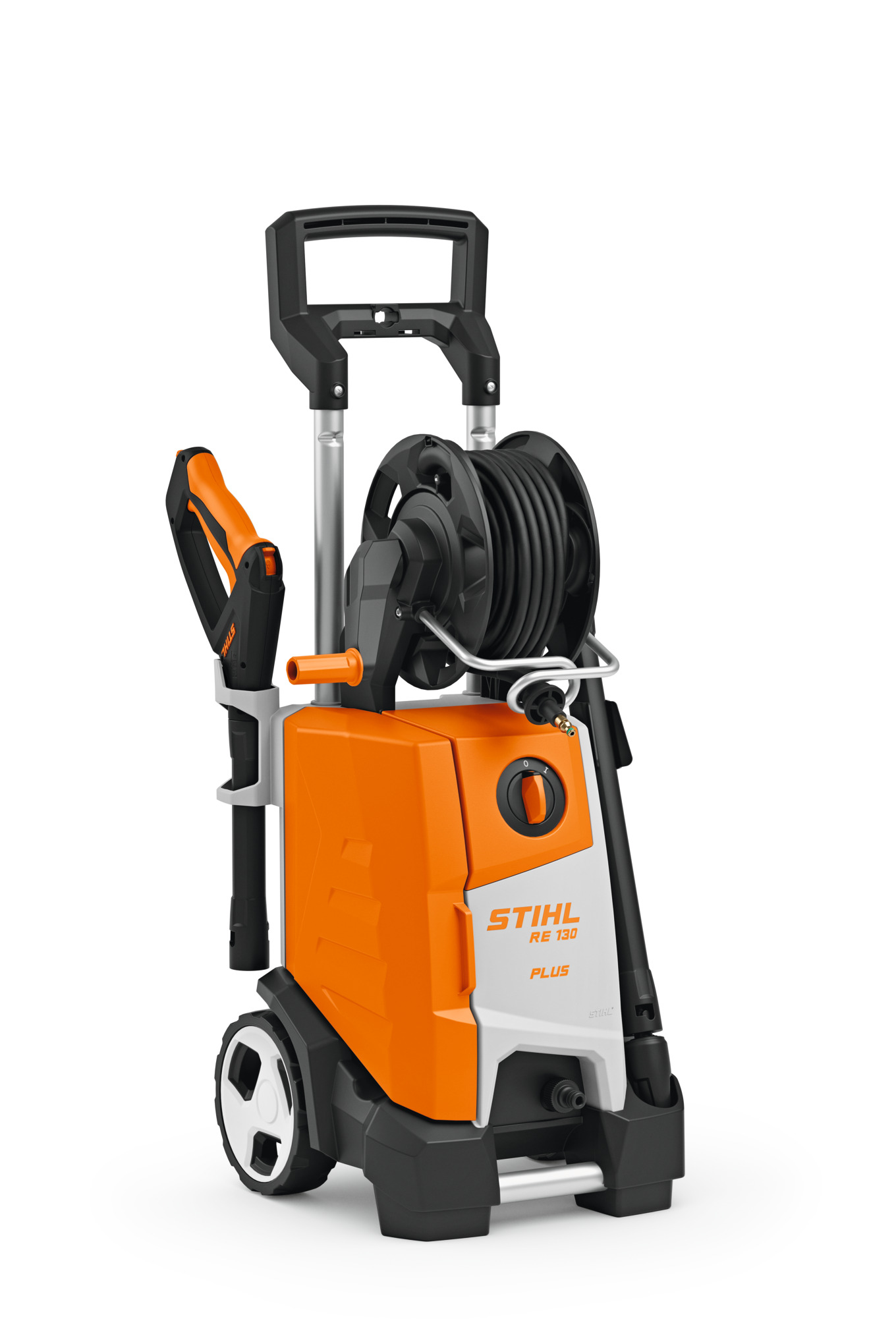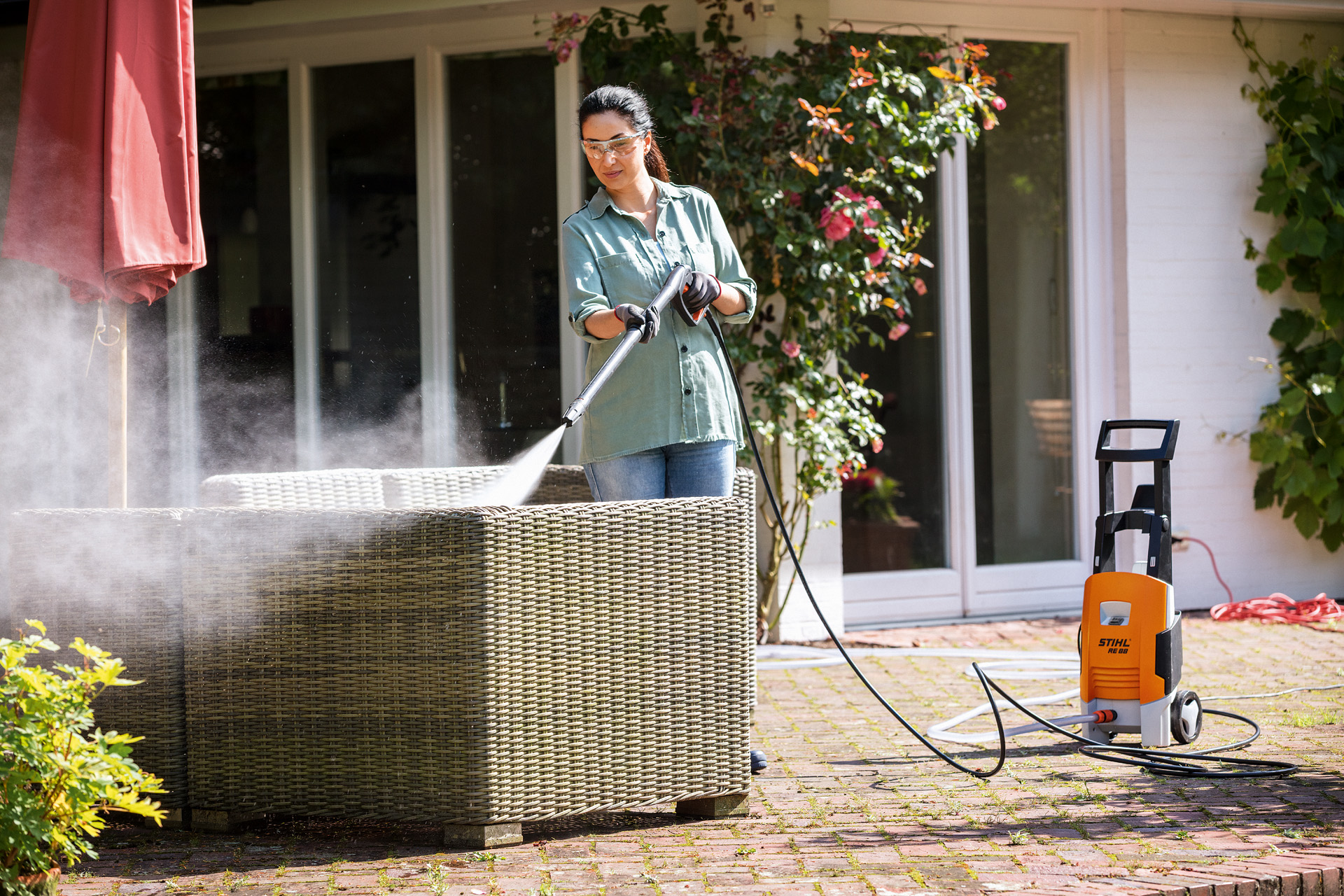How to Clean the Exterior of Your House Effectively
Keep your exterior facade in good condition with regular cleaning. We show you how to clean your facade quickly and effectively.
10.11.2025

Nothing is as exposed to external influences as the exterior of your house. Rain, dust and dirt settle on the surface, and UV rays, heat and frost also have an impact. Over time, visible traces form that not only affect the beauty, but also the condition of your home. Thorough cleaning and care counteract this and can be performed effortlessly using simple household cleaning agents and a pressure washer.
Cleaning your home’s facade: different types of exterior surface
Before getting the pressure washer out of the garage, you should carefully inspect the facade. First, the type of surface is important, as each material requires a different cleaning approach. The condition of the exterior wall must also be considered, and old and damaged facades should only be cleaned after consultation with specialists.

Building facade cleaning: Cleaning brick
Bricks are fired at particularly high temperatures, which causes the pores of the stones to close so that they absorb very little moisture or dirt. Brick exteriors are extremely resilient and durable, so with regular care and easy exterior cleaning you can easily keep this natural material looking great for many years. Fortunately bricks are easy to care for, so dirt can be quickly removed.
Hard-fired bricks can be cleaned quickly and effectively using a high-pressure cleaner.
However, make sure that the facade is made from hard-fired clinker and not another type of brick: while the former can withstand water pressure up to 200 bar, softer bricks can break under high pressure. Particular care should also be taken if there are any loose bricks or damaged joints.
Do not use the brush in a circular motion when cleaning a clinker facade, as this can damage the protective layer on the bricks.

Facade cleaning: Cleaning render
Porous and rough-rendered exteriors in particular are susceptible to dust and soot. Rain causes this dirt to be ingrained into recesses so it cannot easily be removed. Pressure washing is a great cleaning option here.
Stable lime and cement render facades are perfectly happy to be cleaned with pressurised water, though it is important not to work on a single spot for too long, as the water impact could cause paint and material to be removed. A fan jet nozzle helps to protect the material.
Composite resin however, is sensitive to pressure washing. For this reason, you should start by testing it out – with low pressure and sufficient distance – on an unobtrusive area, to see whether pressure washing will damage the facade. Gentle cleaning is particularly recommended if there is a thermal insulation composite system (TICS) under the exterior render: clean composite-resin-rendered and insulated exteriors using a soft brush and a mild cleaning agent.
Over time, render and paint can start to crumble, chalk or flake off. To avoid damage during house exterior cleaning and washing, check the facade for stability and cracks by wiping. Knocking can help you detect any cavities. If you discover any damaged areas in a rendered facade, do not start cleaning it: it’s time for a new coating or renovation work.

House exterior cleaning: Cleaning wooden facades
Wooden cladding requires cleaning from time to time. Treated timber is protected against weathering and moisture and should be regularly cleaned of dirt. Natural wood facades are also prone to greying; if this quality doesn’t appeal to you, the grey “veil” can be removed with thorough cleaning.
Good results can be achieved with a pressure washer, depending on the type of wood. Before cleaning a wooden facade, make sure the cladding is completely sealed and the insulation behind it remains undamaged by water and pressure. As a precaution, clean open wooden facades by hand.
Do not use the rotary nozzle as the hard water jet from this can damage the surface of the wood. Hold the nozzle of the power tool at a good distance (around 25 cm) and start with low working pressure, which you can increase if necessary:
- hardwoods from deciduous trees such as robinia and oak can withstand a maximum water pressure of 110 bar.
- Softwoods from conifers such as spruce and larch can withstand water pressure of around 50 bar.
Work until the whole facade is a uniform colour and then leave the wood to dry. The result will be that your wooden facade shines in its original colour. During cleaning the facade, the top layer of wood is removed, leaving a rough and delicate surface. It is particularly susceptible to moisture and dirt in this condition so it should be properly sealed.
General tips for cleaning the facade
- A pressure washer must not be used in rain or humid environments.
- For safe working at height, you need a second person to hold the ladder.
- Close windows and doors. Mask the light switches and sockets.
- Clear away plants and decorations.
- Test the cleaning agent and water pressure in an unobtrusive spot.
- The best time to clean your facade is on a spring or autumn day, when it is sunny but not too hot, as this speeds up the drying process. It’s also handy to clean after a rain shower, as this means the walls are already wet and so the softened dirt comes off more easily.
If necessary, you can increase the water’s cleaning power by adding a cleaning agent. Check in advance whether your home’s exterior is acid-sensitive. For example, only neutral or alkaline cleaning agents should be used on natural stone and rendered facades. To protect the environment, use biodegradable cleaning agents made from plant-based ingredients.
Cleaning facades using a pressure washer
Step 1: pre-treat
Use the pressure washer to moisten the facade and remove coarse dirt from the wall. For facades that are not delicate, use a surface cleaner. The attachment cleans horizontal and vertical surfaces quickly and without splashing. In addition, the water pressure on the surface cleaner can be set directly and adjusted to the sensitivity of the surface to be cleaned.
Step 2: soak
Apply the cleaning agent over a large area with the high-pressure cleaner and give it a few minutes to take effect; don’t let the surface dry out completely during this time.
Step 3: scrub
If necessary, scrub the wall with a wash brush attachment.
Step 4: rinse
Rinse the dirt and foam from the facade using the surface cleaner. Work from top to bottom – this prevents dirt from getting onto surfaces that have already been cleaned.
Cleaning facades without a pressure washer
Step 1: dampen surface
Spray the facade with a garden hose to moisten it.
Step 2: apply cleaning agent
Distribute the cleaning agent evenly across the house wall. This is easier if you use a sprayer.
Step 3: clean your home’s facade
Brush and scrub the surface from top to bottom, then rinse dirt away with clean water.
Cleaning organic dirt from the exterior of your home
Climbing plants, algae and bird droppings are a nuisance and can permanently damage the exterior of your home. To permanently clean organic dirt from exterior walls, you’ll need the appropriate technology and suitable cleaning agents.
Although ivy is attractively evergreen and prevents house walls from overheating in summer, as well as offering a food source for many birds and insects, this fast-growing climber also puts out anchoring roots which can damage the exterior of your home.
To clear ivy from a wall:
Thoroughly soak the stems with water. Pull or scrape off the roots, one at a time, working from top to bottom. Cut off any stems that are firmly stuck to the wall. Proceed slowly to avoid damaging the facade surface. Once the stems and anchoring roots of the plant have been removed, dig out the main root of the plant as well. Be aware that ivy is a real survivor and must never be tossed onto the compost pile. Instead, let the plant dry out in the sun for a few days; when it’s definitely dead, you can add it to your garden waste.
Algae loves to attack house facades. Many different exterior materials, but especially TICS, are susceptible to algae coating because the outer walls collect large volumes of condensation. This moisture is one of the most important resources for algae and encourages its growth.
An algae accumulation on your home won’t do any harm to your health or the building, though it is often accompanied by fungi and mould, which are harmful and should be removed.
Algae can be reliably removed with our stone and facade cleaner as well as environmentally friendly household cleaning agents such as sodium carbonate (also called washing soda or soda crystals). Always wear safety glasses when using soda crystals, as they are an irritant.
Bird droppings are an aggressive substance that can also spread bacteria. Fortunately, they can be removed from your house wall quite easily. It is usually sufficient to soak spots with warm water and washing-up liquid, and then rinse. A pressure washer can also be used.
Summary: cleaning your House exterior
- Regular and thorough cleaning of your house exterior keeps it in good condition and looking great.
- Some facade types can be cleaned with a pressure washer and others should be cleaned by hand.
- Intact clinker brick, render and wood facades can withstand water pressure. A gentle manual approach is recommended for delicate composite resin and TICS. Damaged and old facades should only be cleaned after consultation with specialists.
- Hot water, a scrubbing brush, and soft soap or washing-up liquid are all you need for tackling small surfaces and light soiling.
- To reduce the environmental impact, use biodegradable cleaning agents.
- Organic dirt, such as climbing plants and algae, can damage exterior facades.
- To permanently remove ivy, you should first detach or cut off all branches and anchoring roots from the facade. Then pull up the plant roots from the soil and leave them to dry out.
- Algae is prone to develop on moist surfaces, and TICS facades are particularly susceptible. Use facade cleaner or soda crystals to remove algae coatings. Always wear safety glasses when using soda crystals, as they are an irritant.
- Bird droppings can be quickly removed with a pressure washer or just water and soft soap.




